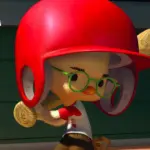
The thriller Old boy directed by famous director Chan-wook Park in 2003 brings fans infinite shock. Many people know that it is the second part of Chan-wook Park's "Revenge Trilogy", located between Sympathy for Mr. Vengeance and Sympathy for Lady Vengeance. However, most people don't know that Old Boy is adapted from the Japanese manga Iron Man and Dragon.

The comic "Iron Man and Dragon" is a so unpopular work. Even though “Old Boy” has won many awards, the comics are still unknown to many fans.

"Iron Man and Dragon" is written by Garon Tsuchiya and drawn by Nobuaki Minegishi. It tells the story of the hero Shinichi Goto, who was imprisoned in a private prison for ten years and was suddenly released. He decided to find out the truth about his imprisonment.

The comic script is a story of revenge, but it is more like a suspenseful one. The layout of the story is reversed like in a criminal case. The whole process is driven by the male protagonist’s perspective. The manipulator of the case is the villain who imprisoned the male protagonist, giving him clues until he found the truth.
The Korean adaptation largely respects the original, but it is not without reason that Park Chan-wook put it in the second part of his “Revenge Trilogy”. A story of revenge, Park Chan-wook has greatly changed the motivation of the villain and the final truth. The final Korean version can be said to surpass the original one and become a strong work in the history of Korean film.

Spike Lee remade a version. Spike Lee’s version cannot be said to be bad, but only not better than the Korean one. If you have watched Spike Lee's original 140+ minute version, you will find more details in the plot.
Next, let's talk about the similarities and differences between the manga, the Korean version, and the American version.
1 . About the private prison in the story, the manga set it on the 7.5th floor. The Korean version also used this setting, but the American version did not.


2. The lead role in Comics is a muscular and handsome uncle at 35 years old. Both the Korean version and the US version are mainly middle-aged men. But I have to say, the US version of Josh Brolin's physique is closer to the setting of the comics.

3. In the three versions, the male lead roles are stuffed into a suitcase and released. He was released in a park in the manga version, on a rooftop in the Korean version, and in a bush in the American version.


4、In the manga, the male protagonist went to the sushi restaurant to fill his stomach, while the Korean version followed this plot and added a scene of eating raw octopus, which was classic in film history. However, the American version skipped this part, the male protagonist went to find his good friend directly.
5. In the manga and the Korean version, the male protagonist fought with street gangsters to practice. While in the American version, the male protagonist becomes a violent baseball player.
6. In the Korean version, the long shot of the male protagonist breaking through the private prison is classic. The American version also used the long shot to pay tribute to the Korean version. It is worth noting that this scene did not exist in the comics. In the manga, he just asked a guy for clues and slipped away.
7. The heroine of the story is a young sushi waiter in the manga. The Korean version follows the design and riches of her background (the male protagonist’s daughter) so that the story develops into incest. Finally, when the truth was exposed, the audience suffers heart damage along with the male protagonist. While in the US version, the heroine follows the setting of the Korean version but changes her profession to a nurse.


8. In the three versions, there are direct descriptions of the sex scenes of the two protagonists.
 9. In the manga, the male protagonist’s good friend runs a bar, but the Korean version changed it to open an Internet cafe, while the American version followed the setting of the manga.
9. In the manga, the male protagonist’s good friend runs a bar, but the Korean version changed it to open an Internet cafe, while the American version followed the setting of the manga.


10. In the manga, the villain was equipped with a beautiful secretary, but in the Korean version, it is changed to a white-haired thug, in the American version, it followed the setting of the manga again.


11. There are many characters in the manga, which are not mentioned in the two versions of the film, such as observers, teachers, etc. The theme between the two camps in the comics is games, while in the movies there is no mention of the concept. However, all three share the same storyline.

12. There is a way to recall the real identity of the villain by looking through the classmate's records. In the comics, the villain uses plastic surgery to make the method invalid; while the movie versions remained the detail.

13. In the comics, the role of the hypnotist is very important in the later stage, because they were hypnotized and fell in love with each other. But the hypnotist inadvertently left a "blank five minutes" for the heroine during the hypnosis process, which made the ending different in the manga and film versions.

14. In the three versions, There is a big difference in the motivation of the final fight between the villain and the male protagonist.
In the comics, it was because the male protagonist was moved by the villain's singing when he was a child, and the villain thought it was a great shame. That was why the villain prisoned him. Then he had a revenge plan.
In the Korean version, Park Chan-wook changed his motivation greatly. The villain loved his sister since he was a child. The male protagonist accidentally discovered an incest relationship and spread the scandal, which lead to the sister's suicide.
In the American version, The incest between the younger sister and her father the villain spread the scandal to others, causing the whole family to be killed by the father. In the end, the father shot himself, leaving the disabled villain behind, which finally led to a plan for imprisonment and revenge.
15. In three versions, the villains all committed suicide.

16. Ending:
In the comics, after the villain commits suicide. The male protagonist and the heroine live normal life. In the last dream of the male protagonist, he dreamed that the heroine commits suicide by jumping off a building because of the hypnosis of “five blank minutes”. When he woke up, he found it was just a dream. It was an open ending.
While in the Korean version, the male protagonist begged the hypnotist to seal his memory. The male and female protagonists seemed to continue to live with their existing memories.
The ending of the US version is that after the male protagonist learns the truth, he left the female protagonist and returned to the private prison to spend the rest of his life.
Conclusion
Initially, the story of "Iron Man and Dragon" only revolved around themes of revenge. While the Korean version of "Old Boy" incorporated Park Chan-wook's own strong personal elements, such as incest, gore, and imprisonment. The later American version, which advocated a simple narrative and had a strong commercial atmosphere, was naturally not highly rated.
Because of this story, whether the villain's motives are good or bad. It tells us to be kind. Whether it is sand or stone, will eventually sink into the river. Your every move will have an unpredictable impact on others.








































Share your thoughts!
Be the first to start the conversation.